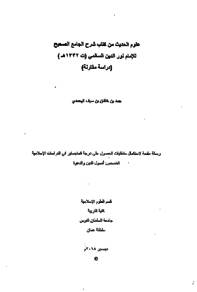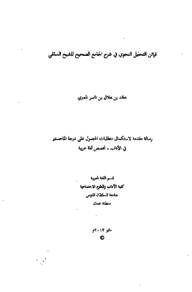Document
علوم الحديث من كتاب شرح الجامع الصحيح للإمام نور الدين السالمي : دراسة مقارنة.
Publisher
جامعة السلطان قابوس
Gregorian
2018
Language
Arabic
Subject
English abstract
The introduction gives an account of Imam Al-Salmi, his contribution to hadith terminology. Then, broader terms are highlighted like Sunnah, hadith, tradition, vestige, reports, witnesses and follow-ups.
The first chapter explores six types of hadiths according to authority like sacred, traceable anddiscontinued hadiths as wellintersected, musnad andconnected hadiths
The second chapter reviews two types of hadithes based on the number and the characteristics of the narrators: mutawatir and ahad hadiths. The latter type includes three subcategories: gharīb, azizand mash-hur hadiths.
Chapter three reviews accepted hadiths and their qualifications highlighting four types: authentic hadith, good hadith, extrinsically soundauthentic hadiths and good hadith. It also gives an account ofother types of accepted hadiths like perfect hadith, mukhtalif hadiths as abrogating and abrogatedHadiths
Chapter four underpins types of rejected hadiths due to defects in the chain of narration or the integrity and the accuracy of the narrators. The first section of the chapter explores weak hadiths due to obvious defects in the chain of narration like hanging,
mursaland perplexinghadiths or due to intricate defect in the same like deceitful and concealed mursal hadiths. The second section of the chapter addresses weak hadiths due to defects in the integrity of the narrator like forged hadiths, disregarded hadiths, the narration of innovator and the anonymity of the narrator. The third section explores weak hadiths based on the accuracy of the narrator likeanomalous hadiths, the addition in the hadith from trustworthy narrator, interpolated hadiths, disclaimed hadiths, inverted hadiths, mu'alal hadiths, defective hadiths, inconsistent hadiths, dot and vowel-distorted hadiths.
Chapter five deals with literature on hadith narrators in terms of method or way of transmitting the narration, forms of transmission and way of performance. The dissertation concluded that Imam Al Salmi was a well-rehearsed and establishedas a scholar in hadith science as evident in his exegesis of Jami Sahin and his other books. He agrees on the definition of the majority of hadith terms; however, the word hadith, according to him, is restricted to verbal tradition not including the deeds or the approval of the prophet.In comparison to traditionists viewpoint, he argued in favour of the jurist viewpoint that acceptance of hadith rests upon the integrity of the narrator even if the chain of narration is interrupted; thus, he accepts interrupted, mursalhadiths, literally transmitted hadiths as well perplexing hadiths under special conditions. He also accepts the narration of reliable innovator if he considers lying is prohibited and the additions from a reliable narrator based on considerable evidence set by jurists.
Member of
Resource URL
Arabic abstract
تناولت الرسالة المصطلحات الحديثية الواردة في كتاب شرح الجامع الصحيح للإمام السالمي (دراسة مقارنة) ، واشتملت الرسالة على مقدمة ، وتمهيد عام وخمسة فصول وخاتمة :
واشتمل التمهيد على التعريف بالإمام السالمي ، وجهوده في كيفية التعامل مع المصطلحات الحديثية، وذكر المصطلحات العامة (السنة، الحديث، الأثر، الخبر، الشواهد والمتابعات ).
وجاء الفصل الأول مبينا أنواع الحديث حسب قائله، وذلك بنسبة الحديث إلى من أضيف اليه وجاء في ستة مباحث القدسي والمرفوع والموقوف والمقطوع والمسند والمتصل ). وأما الفصل الثاني فاحتوى على أنواع الحديث حسب عدد رواته، وصفات هؤلاء الرواة، وجاء هذا الفصل على مبحثين (المتواتر والآحاد، واشتمل الأحاد على الغريب والعزيز المشهور).
والفصل الثالث جاء موضحا أنواع الأحاديث المقبولة، وما بها من شروط، والتي يعمل بها، واحتوى هذا الفصل على أربعة مباحث (الحديث الصحيح الحديث الحسن وأنواعه الصحيح الغيره والحسن لغيره وألفاظ تطلق على المقبول کالمحكم ومختلف الحديث، الناسخ والمنسوخ).
وأما الفصل الرابع فاشتمل على أنواع الأحاديث المردودة، بسبب وجود سقط في سند الحديث، أو ما يتعلق بصفات الراوي بسبب الطعن في عدالته أو ضبطه، وجاء على ثلاثة مباحث:
المبحث الأول : الضعيف بسبب السقط من الإسناد ، واشتمل على السقط الظاهر ( المعلق، المرسل ، المنقطع ، المعضل ) والسقط الخفي ، وبه فرعان ( المدلس ، المرسل الخفي).
والمبحث الثاني: الضعيف بسبب الطعن في عدالة الراوي (الموضوع المتروك ورواية المبتدع والجهالة بالراوي). ج والمبحث الثالث: الضعيف بسبب الطعن في ضبط الراوي (الشاذ وزيادة الثقة.
المدرج، المنكر، المقلوب، المضطرب، المصحف، المحرف ، المعلل، وأما الفصل الخامس فجاء مبينا لعلوم الرواة، من تحمل أسماء الحديث وأدائه، وطرق التحمل وصيغ الأداء. وقد تبين لنا مدى تمكن الإمام السالمي من علم الحديث وتبحره في شرحه للجامع وكتبه الأخرى، وكان له اسهامات في هذا العلم ، واتفق مع علماء الحديث والأصول والفقهاء، في كثير من المصطلحات الحديثية المستعملة في هذا الفن ، وخالفهم في بعضها من وجهة نظره، فيرى أن مصطلح ( حديث ) يجب أن يحصر في السنة القولية فقط، ولا يطلق على الفعلية والتقريرية، ويتفق مع جمهور الفقهاء في أن العبرة في قبول الرواية هي عدالة الراوي، ولو كان السند منقطعا، بخلاف المحدثين ، وعليه فهو يقبل بالحديث الذي روي بلاغا أو المعنعن ويأخذ بالحديث المنقطع والمرسل والمعضل وفق شروط معينة، ويرى الإمام السالمي قبول رواية المبتدع العدل اذا دان بتحريم الكذب، وبأن زيادة الثقة مقبولة وفق قرائن معتبرة عند الفقيه، ولا يردها أو يقبلها مطلقا.
واشتمل التمهيد على التعريف بالإمام السالمي ، وجهوده في كيفية التعامل مع المصطلحات الحديثية، وذكر المصطلحات العامة (السنة، الحديث، الأثر، الخبر، الشواهد والمتابعات ).
وجاء الفصل الأول مبينا أنواع الحديث حسب قائله، وذلك بنسبة الحديث إلى من أضيف اليه وجاء في ستة مباحث القدسي والمرفوع والموقوف والمقطوع والمسند والمتصل ). وأما الفصل الثاني فاحتوى على أنواع الحديث حسب عدد رواته، وصفات هؤلاء الرواة، وجاء هذا الفصل على مبحثين (المتواتر والآحاد، واشتمل الأحاد على الغريب والعزيز المشهور).
والفصل الثالث جاء موضحا أنواع الأحاديث المقبولة، وما بها من شروط، والتي يعمل بها، واحتوى هذا الفصل على أربعة مباحث (الحديث الصحيح الحديث الحسن وأنواعه الصحيح الغيره والحسن لغيره وألفاظ تطلق على المقبول کالمحكم ومختلف الحديث، الناسخ والمنسوخ).
وأما الفصل الرابع فاشتمل على أنواع الأحاديث المردودة، بسبب وجود سقط في سند الحديث، أو ما يتعلق بصفات الراوي بسبب الطعن في عدالته أو ضبطه، وجاء على ثلاثة مباحث:
المبحث الأول : الضعيف بسبب السقط من الإسناد ، واشتمل على السقط الظاهر ( المعلق، المرسل ، المنقطع ، المعضل ) والسقط الخفي ، وبه فرعان ( المدلس ، المرسل الخفي).
والمبحث الثاني: الضعيف بسبب الطعن في عدالة الراوي (الموضوع المتروك ورواية المبتدع والجهالة بالراوي). ج والمبحث الثالث: الضعيف بسبب الطعن في ضبط الراوي (الشاذ وزيادة الثقة.
المدرج، المنكر، المقلوب، المضطرب، المصحف، المحرف ، المعلل، وأما الفصل الخامس فجاء مبينا لعلوم الرواة، من تحمل أسماء الحديث وأدائه، وطرق التحمل وصيغ الأداء. وقد تبين لنا مدى تمكن الإمام السالمي من علم الحديث وتبحره في شرحه للجامع وكتبه الأخرى، وكان له اسهامات في هذا العلم ، واتفق مع علماء الحديث والأصول والفقهاء، في كثير من المصطلحات الحديثية المستعملة في هذا الفن ، وخالفهم في بعضها من وجهة نظره، فيرى أن مصطلح ( حديث ) يجب أن يحصر في السنة القولية فقط، ولا يطلق على الفعلية والتقريرية، ويتفق مع جمهور الفقهاء في أن العبرة في قبول الرواية هي عدالة الراوي، ولو كان السند منقطعا، بخلاف المحدثين ، وعليه فهو يقبل بالحديث الذي روي بلاغا أو المعنعن ويأخذ بالحديث المنقطع والمرسل والمعضل وفق شروط معينة، ويرى الإمام السالمي قبول رواية المبتدع العدل اذا دان بتحريم الكذب، وبأن زيادة الثقة مقبولة وفق قرائن معتبرة عند الفقيه، ولا يردها أو يقبلها مطلقا.
Category
Theses and Dissertations


